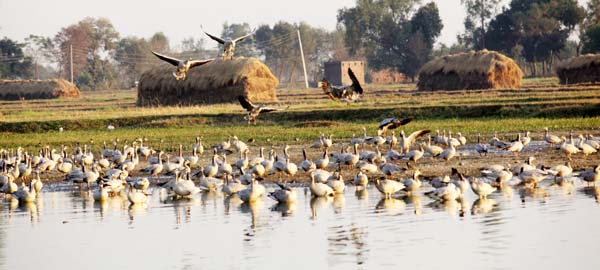Nishikant Khajuria
Gharana wetland, situated near the Indo-Pak International Border in R S Pura tehsil of Jammu district, has been attracting thousands of migratory birds, including rare species of bar-headed Gees to make the place their winter habitant.
These migratory birds such as Greylag geese, Common teal, Pintail, Mallard, Little cormorant and Bar-headed geese, every year fly a distance of more than 1000 miles over the Himalayas in a single day to reach here from their breeding grounds in Central Asia and other parts of the world to escape the harsh winters. Approximately, 20,000 birds come here during the winter from Siberian Tundra, Central Asia and as far as East Europe. Normally, these birds arrive in December and stay till the end of February.
However, during the past few years, a decline in the number of migratory birds as well as duration of their stay here is being witnessed owing to continuous tussle between the locals and the Wildlife Departments, lack of mutual understanding between them, inadequate awareness and unprecedented delay in implementation of the Government projects.
For the locals, particularly small farmers of Gharana and adjoining villages, these migratory birds are the enemy since they destroy their crop during their stay here for two-three months. Official formalities are hurdle in paying compensation to affected people who are therefore turning a deaf ear to repeated appeals of the Wildlife authorities not to terrorizing the birds. These hostile villagers fire crackers and set smoke to keep the birds fly away for saving their crops. These people even demand that the wetland should be closed as these migratory birds are threat to the survival of locals. There is no provision of compensation for the loss of crop due to wildlife.
Encroachment of the wetland by locals is another major reason behind thinning turnout of the migratory birds. Continuous encroachment has reduced size of the wetland area to about 500 square meters, less than half of its official size. Many villagers claim that some parts of the land which is under the Gharana reserve is their private property.
Even as the Gharana wetland was notified as protected waterbody in 1981 and declared as Important Birds Areas (IBA) in 1986, the Government has failed to demarcate the area owing to some technical problems in the revenue record. This is the reason that the Wildlife Department has failed to implement its ambitious project to convert it into a major tourist attraction and safeguard the habitat for migratory birds. Out of 1,500-kanal notified land, only 115 kanal have been demarcated in the revenue records. Spoiling the environment for the birds, some locals also pollute the water and surrounding area by letting the drainages flow into the pond. These hostile conditions are leading to thinning the number of migratory birds and shortening of their stay in the wetland.
On the other hand, owing to problem with the villagers, the Wildlife Department has not been able to maintain the wetland properly .Whenever an attempt is made to clear the weeds from the ponds and clean the area, the villagers protest thus forcing the officials to seek the help of Police. At the number of time, Police even registered cases against some villagers under the Wildlife Act but it only increased animosity between the locals and the concerned authorities.
Bad condition of link road to Gharna wetland and inadequate facilities for the visiting bird watchers are other problems. Despite being a host of migratory birds of rare species, the place is attracting very few people, particularly the bird watchers, only because of inadequate communication and no tourism facilities here.
There is need for developing Gharana wetland as a latest tourist destination within and outside the State with providing adequate infrastructure in the area like good roads and communication in collaboration with all the stakeholders, particularly local people who need to be taken into confidence by explaining them benefits of the project. Development of Gharana wetland would not only promote tourism but also generate employment and economic resources for the people residing in the surroundings of this wetland. Only an awareness among locals in this regard can solve the man-wildlife conflict and help this place to get due importance and development, which would ultimately attract more tourists and boost economic health of the villagers.
According to the Chief Wildlife Warden A K Singh, the demarcation matter has been taken up with the District administration while the work on Management Plan by WWF was on for conservation and development of the Gharana wetland. Field survey for the Management Plan has been completed and the recommendations are being sent to the Government of India very soon for the approval, he added.
Once the development of infrastructure take place with proper management of the wetland, the place will surely invite more tourists resulting into a boost to business of the locals who may then start taking arrival of these migratory birds as a good sign of economic health instead of a threat to their crop.


